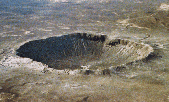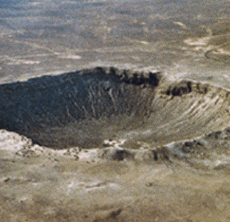Craters on Earth
 (308K GIF)
(308K GIF)
This is the Barringer Meteor Crater in Arizona. The diameter is 1.2 kilometers, and it is 49,000 years old. (Courtesy of D. Roddy and LPI)
 (199K GIF)
(199K GIF)
This is Wolfe Creek Crater in Australia. It is partly buried under wind blown sand. Its crater rim rises 25 meters (82 feet) above the land and the crater floor is 50 meters (164 feet) below the rim. (Courtesy of V. L. Sharpton, LPI)
 (316K GIF)
(316K GIF)
These twin impact craters are Clearwater East and West craters located in Quebec, Canada. They were formed at the same time by two separate but probably
related meteorite impacts. This rarely occurs on Earth. The larger Clearwater Lake West (left) shows a ring of islands that has a diameter of about 10 kilometers (6 miles). They constitute a raised area and are covered with impact melts. The central peak of the smaller Clearwater Lake East (right) is submerged. (Courtesy NASA/LPI)
 (439K GIF)
(439K GIF)
This is Roter Kamm Crater located in South West Africa in the Namibia Desert. Scientists believe that a meteorite hit this area about 5 million years ago. The crater floor is covered by sand dunes. (Courtesy of W. U. Reimold and LPI)
 (218K GIF)
(218K GIF)
This is a space radar image of the Roter Kamm Crater. The data were acquired by the Spaceborne Imaging Radar-C/X-Band Synthetic Aperture Radar (SIR-C/X-SAR) instrument onboard space shuttle Endeavour on April 14, 1994. The area shown is approximately 25.5 kilometers (15.8 miles) by 36.4 kilometers (22.5 miles.) (Courtesy NASA/JPL)









